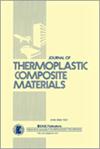2,5-Tetrahydrofurandimethanol as a sustainable comonomer for modification of polyethylene terephthalate: Liter-level pilot test and non-isothermal crystallization kinetics
IF 3.4
4区 材料科学
Q2 MATERIALS SCIENCE, COMPOSITES
引用次数: 0
Abstract
2,5-tetrahydrofurandimethanol (THFDM), which is an alicyclic diol in products of 5-hydroxymethylfurfural (HMF), is a sustainable monomer to protect environment for replacing the role of isophthalic acid (IPA) and 1,4-cyclohexanedimethanol (CHDM) which were optimized polyethylene terephthalate (PET) performance. By direct esterification method, poly (ethylene-co-tetrahydrofurandimethanol terephthalate) (PETT) was synthesized in 2.5 L reactor. The results showed that the contents of THFDM in copolyester were less than that feeding ratio attributed to its lower reaction reactivity. The color of PETT slightly turned yellow. PETT performed broader processing temperature window, while Tg maintained in good range because of the cyclic structure of THFDM. Especially, the cold crystallization occured in PETT but not in PET after finishing melt crystallization. Otherwise, the thermal stability and crystal structure of PETT remained the same as PET. The crystallization activity of PETT became significantly lower than PET. What proved THFDM was effective in reducing PET crystallinity was that crystallization kinetics using Jeziorny theory and the trend of activation energy of melt crystallization which was calculated by Friedman method. And PETT-2 fibre had comparable mechanical property to PET fibre. In the advancement of green chemistry, THFDM has added a choice of cyclic bio-based comonomers.2,5-四氢呋喃二甲醇作为改性聚对苯二甲酸乙二醇酯的可持续共聚单体:升级中试和非等温结晶动力学
2,5-四氢呋喃二甲醇(THFDM)是5-羟甲基糠醛(HMF)产品中的一种脂环二醇,是替代经性能优化的聚对苯二甲酸乙二醇酯(PET)的间苯二甲酸(IPA)和1,4-环己二甲醇(CHDM)的环保可持续单体。采用直接酯化法,在2.5 L反应器中合成了聚四氢呋喃二甲醇对苯二甲酸乙酯(PETT)。结果表明,由于反应活性较低,共聚酯中THFDM的含量低于投料比。PETT的颜色稍微变黄了。由于THFDM的循环结构,PETT具有较宽的加工温度窗,而Tg保持在较好的范围内。特别是熔融结晶完成后,PET发生冷结晶,而PET不发生冷结晶。除此之外,PETT的热稳定性和晶体结构与PET相同。PETT的结晶活性明显低于PET。利用热激理论计算结晶动力学和Friedman方法计算熔体结晶活化能趋势,证明了THFDM降低PET结晶度的有效性。PET -2纤维具有与PET纤维相当的力学性能。在绿色化学的进步中,THFDM增加了循环生物基共聚物的选择。
本文章由计算机程序翻译,如有差异,请以英文原文为准。
求助全文
约1分钟内获得全文
求助全文
来源期刊

Journal of Thermoplastic Composite Materials
工程技术-材料科学:复合
CiteScore
8.00
自引率
18.20%
发文量
104
审稿时长
5.9 months
期刊介绍:
The Journal of Thermoplastic Composite Materials is a fully peer-reviewed international journal that publishes original research and review articles on polymers, nanocomposites, and particulate-, discontinuous-, and continuous-fiber-reinforced materials in the areas of processing, materials science, mechanics, durability, design, non destructive evaluation and manufacturing science. This journal is a member of the Committee on Publication Ethics (COPE).
 求助内容:
求助内容: 应助结果提醒方式:
应助结果提醒方式:


